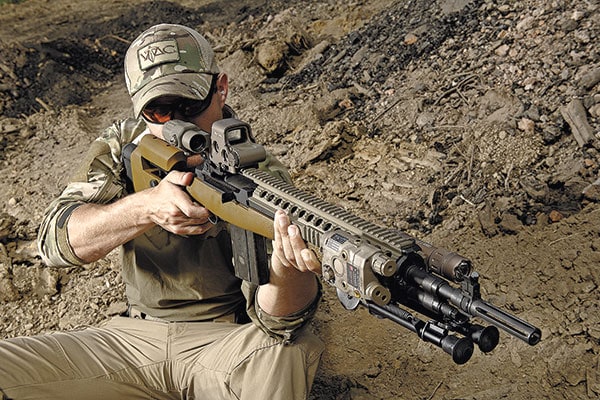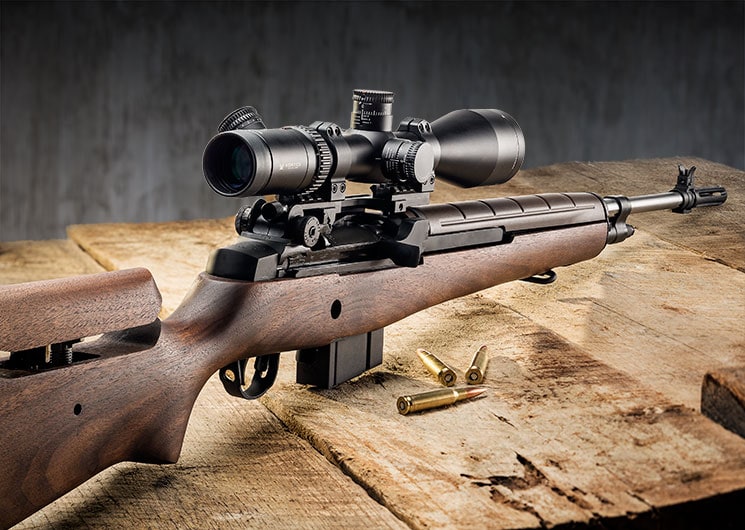The obsession of civilian firearm enthusiasts with military firearms is clear and evident. Manufacturers have long been bringing replicas or modified versions to the market and people accept them with their hands wide open.
Such a firearm is the M1A rifle. Derived from the famous M14 rifle of the U.S Military. It is a very respected and desired firearm for rifle lovers. But is the price really worth it? Or maybe there are some other factors you should be aware of? Allow me to clarify your doubts here.
An Overview of the M1A Rifle
The M1A was developed in 1974 by Elmer C. Ballance as a semi-auto civilian version of the M14 rifle. Introduced in the early 1950s, the M14 was a rugged and reliable rifle. But it’s heavy weight and uncontrollability in full-auto mode along with a few other features resulted in it being phased out by the mid-1960s.
The Military then adopted the M16 rifle. But the M14 was still used in a limited capacity by the U.S Military. In fact, it is still used by some marksman units of the Army.
Anyways, the phasing out of the M14 resulted in an influx of surplus components and Springfield Armory took it as an opportunity. Hence, the M1A was born. The basic difference between the M14 and M1A is the fire selector switch, receiver manufacturing process, and the bayonet lug.
But basically, the M14 can switch to a full-auto mode, whereas the M1A is only a semi-auto rifle chambered in .308 Winchester or 7.62 NATO.
The M1A rifle is available in a number of variants. These include Loaded Rifles, Match Rifles, Scout Scout, and SOCOM rifles. Each of these features different stocks, barrel lengths, and other components.
The earlier models of the M1A rifles featured a bayonet lug as well. But that got removed after the 1994 assault weapon ban. The M1A rifle can be found in walnut or fiberglass stock variants. Even in tactical chassis like the SOCOM and Loaded versions.
However, the M1A rifle has a reputation for being quite pricey. Especially in today’s market when there are a lot of options to choose from.
What the M1A Does Best
Since the M1A is a derivative of the M14. Which itself was a derivative of three legendary combat rifles. It can be deemed fit for combat to some extent. The M1A is offered in several different variants by Springfield Armory.
But generally speaking, the M1A is a great hunting, survival, and defense rifle. Specific versions like the M1A National Match and Super Match variants have been designed for short and long range competitions.
The M1A is a long rifle with ample receiver space to mount optics. Which makes it a perfect scout rifle. In fact, the M1A rightfully fits the definition of a ‘scout rifle’ as proposed by Col. Jeff Cooper.

These rifles are widely used for hunting and scouting purposes. Thanks for the .308 Win caliber which is a versatile hammer for everything from deer to black bears.
The .308 is 7.62 NATO is a long range caliber with an effective range of 800-1000 yards. So a fine trained pair of hands and eyes can do wonders with the M1A on long range targets.
Talking about survivability or defense applications, the M1A’s semi-auto operation and 20 round detachable magazine deliver good controllability and ammo capacity.
The build quality and durability of the M1A are just awesome. You can use it throughout difficult terrain, drop it or even stomp it. The rifle will still function flawlessly. But most people who own it will handle it with extreme care due to its high price tag.
Where the M1A Falls Short
With a design more than five decades old. The M1A has tried hard to put with the latest firearm designs by offering upgrades and variants to the primary design. While the rifle is great for a few applications, there are also a few situations where it doesn’t work that well.

For instance, the first and foremost issue many users reported was the heavyweight of this rifle. The original M1A introduced in 1974 had a Walnut stock and weighed between eight to 12 pounds on an empty magazine.
This weight is obviously quite cumbersome for a hunting or mountain rifle. Maybe people didn’t mind this back then. But as time progressed, lightweight and ultra lightweight rifles hit the market. M1A introduced a lighter chassis like the SOCOM variant.
Another issue people face with M1A is the limited customizability. Especially if you’re using a wooden stock version. These rifles often feature an angled grip rather than a pistol grip. Plus, the options to add multiple accessories are limited. Since you cannot expect it to have a floating barrel, free-float handguard, quad rails, and things like that.
On the other hand, the M1A is a fairly pricey rifle. Costing more than $1,500. Many people don’t like compromising on modularity and customizability. So rather go for a high-end AR-15 (if having a heavier caliber like the 7.62 is not a requirement).
The M1A also doesn’t have drop-free mags like the AR’s and disassembly and cleaning of this rifle requires some practice and patience. It’s not your regular easy-takedown AR.
How to Take Advantage of an M1A Rifle
The aftermarket availability of accessories and upgrades for the M1A is somewhat in the medium range. Neither too limited, nor too widespread. Springfield Armory offers several different variations of the M1A. Each is designed to suit a specific purpose like competition, scouting, or hunting. So the major focus for upgrades is on accessories.
The first accessory you may want to look out for the M1A is a cheek riser. Most of these rifles come with an angled buttstock. This angle can either be too steep or too low for some users. Additionally, having a cheek riser lets you better adjust the cheek weld and attain better visibility and accuracy.

Since this is a magazine-fed rifle. You should have additional M1A magazines helping you with practice sessions and also keeping spares. People who tend to undergo extensive shooting sessions should definitely invest in multiple magazines.
The M1A comes with a drilled and tapped receiver for mounting optics. Having a scope on your M1A is extremely essential due to the long effective range of this rifle. When looking for scopes, you should also take a look at the best M1A scope mounts.
While the M1A comes fitted with a muzzle brake. It is obvious that it won’t be refined to the individual taste of every user. Plus, those using this rifle for precision applications may need a hybrid muzzle brake to dampen the recoil and muzzle rise.
If you’re looking for a complete overhaul of this rifle. You can invest your money in a good stock. There’s a wide range of M1A stocks out there that can turn your rifle into a tacti-cool weapon. Offering you things like an adjustable rear, rail embedded handguard, and QD mounts for slings or accessories.
Further Reading on the M1A Rifle
The M1A rifle is a very wide topic in itself. From accessories to maintenance and utilizing its full potential. There’s a lot to learn about this rifle. For instance, the first thing you should learn about is how to properly clean your M1A rifle.
This is very important because the M1A takes a bit more effort to disassemble and put back. Compared to other modern rifle designs. Especially bolt actions. The disassembly of an M1A is a time taking process and can result in havoc if not done properly. We’ve put up a dedicated guide on how to do that and also clean this rifle.

As you dig deeper into the concepts of this rifle. There’s one very inevitable question that’ll cross your mind. As the M1A is chambered in the 7.62 NATO cartridge. One may imagine the pros and cons of the M1A vs an AR-10. Since both these rifles shoot the same bullet. But the AR-10 has a reputation for being more customizable.
Since this question is inevitable, we’ve already put up an answer to this. A quick look at our M1A vs AR-10 guide will balance your opinions and give you a clearer perspective.
Conclusion
The M1A rifle is a civilian version of the U.S Military’s M14 rifle. With the only major difference being the lack of a full-auto fire capability. The M1A is great hunting, scouting, and competition rifle. With multiple variants offered by Springfield Armory suiting specific applications.

The rifle is significantly customizable and the .308 WIn / 7.62 NATO caliber makes it quite versatile. The disassembly is a bit tricky but can be easily learned after a couple of runs.


